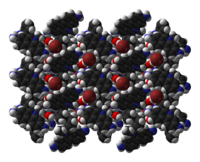Ethidium bromide
 |
|
 |
|
 |
|
| Names | |
|---|---|
|
IUPAC name
3,8-Diamino-5-ethyl-6-phenylphenanthridinium bromide
|
|
| Other names
2,7-Diamino-10-ethyl-6-phenylphenanthridinium bromide, 2,7-Diamino-10-ethyl-9-phenylphenanthridinium bromide, 3,8-Diamino-1-ethyl-6-phenylphenantridinium bromide, 5-Ethyl-6-phenyl-phenanthridine-3,8-diamine bromide, Ethidium bromide, Homidium bromide, EtBr
|
|
| Identifiers | |
|
1239-45-8 |
|
| 3D model (Jmol) | Interactive image |
| ChEBI |
CHEBI:4883 |
| ChEMBL |
ChEMBL284328 |
| ChemSpider |
14034 |
| ECHA InfoCard | 100.013.622 |
| EC Number | 214-984-6 |
| KEGG |
C11161 |
| PubChem | 14710 |
| RTECS number | SF7950000 |
| UNII |
059NUO2Z1L |
|
|
|
|
| Properties | |
| C21H20BrN3 | |
| Molar mass | 394.294 g/mol |
| Appearance | Purple-red solid |
| Melting point | 260 to 262 °C (500 to 504 °F; 533 to 535 K) |
| ~ 40 g/l | |
| Pharmacology | |
| QP51AX06 (WHO) | |
| Hazards | |
| R-phrases | R25 R36/37/38 R46 |
| S-phrases | S22 S24/25 S26 S36/37/39 S45 S53 |
| NFPA 704 | |
| Flash point | > 100 °C (212 °F; 373 K) |
|
Except where otherwise noted, data are given for materials in their standard state (at 25 °C [77 °F], 100 kPa).
|
|
|
|
|
| Infobox references | |
Ethidium bromide is an intercalating agent commonly used as a fluorescent tag (nucleic acid stain) in molecular biology laboratories for techniques such as agarose gel electrophoresis. It is commonly abbreviated as "EtBr", which is also an abbreviation for bromoethane. When exposed to ultraviolet light, it will fluoresce with an orange colour, intensifying almost 20-fold after binding to DNA. Under the name homidium, it has been commonly used since the 1950s in veterinary medicine to treat trypanosomiasis in cattle, a disease caused by trypanosomes. The high incidence of antibiotic resistance makes this treatment impractical in some areas, where the related isometamidium chloride is used instead. Ethidium bromide may be a mutagen, although this depends on the organism exposed and the circumstances of exposure.
As with most fluorescent compounds, ethidium bromide is aromatic. Its core heterocyclic moiety is generically known as a phenanthridine, an isomer of which is the fluorescent dye acridine. Absorption maxima of EtBr in aqueous solution are at 210 nm and 285 nm, which correspond to ultraviolet light. As a result of this excitation, EtBr emits orange light with wavelength 605 nm.
...
Wikipedia

